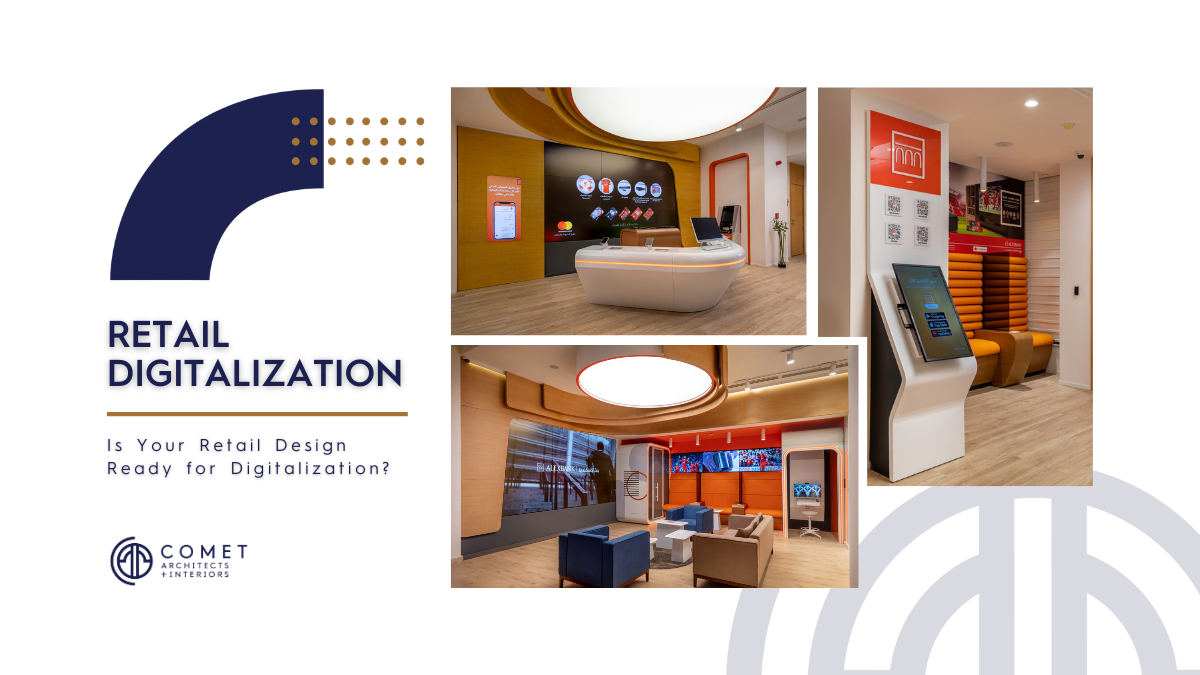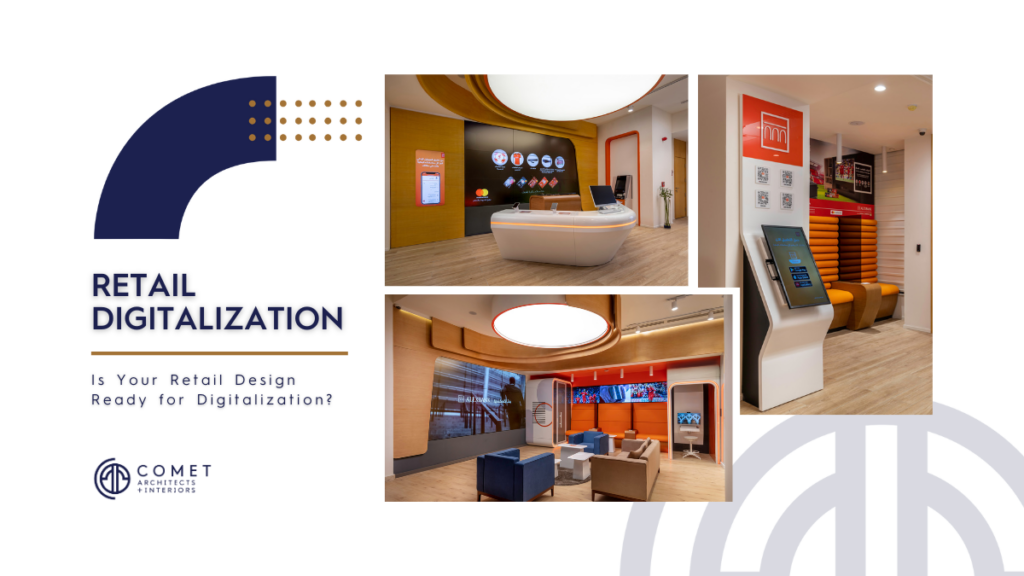Is Your Retail Design Ready for Digitalization?
- Home
- /
- Design Tips
- /
- Is Your Retail Design Ready for Digitalization?

Is Your Retail Design Ready for Digitalization?
Retail design is more than just a beautiful facade and neatly arranged shelves. Retail experience is what draws in customers, and it will only get more important as retailers begin adopting digital technologies.

Retail Design: The Transformation
As technology continues to evolve, so does the retail landscape. And while some may see this as a threat, others see it as an opportunity to capitalize on the ever-changing landscape and adapt their business models to stay ahead of the curve.
One of the biggest changes in recent years has been the rise of digitalization and its impact on retail design. To stay relevant and keep up with the competition, retailers must be willing to embrace change and adapt their stores to meet the needs of today’s digital consumers.
What does this mean for retail design?
There are a few key things that need to be taken into consideration when it comes to adapting your store for a more digital age:
The customer experience: In today’s world, customers expect a seamless, personalized experience both online and in-store. This means that your store must be designed with the customer journey in mind, taking into account all touchpoints from discovery to purchase.
Omnichannel integration: A successful retail strategy nowadays requires a seamless omnichannel approach. This means that your physical store must be integrated with your online presence, providing a consistent brand experience across all channels.
Data-driven decision-making: With access to data and analytics tools, retailers can now make informed decisions about their store design based on customer behavior and preferences. By using data to understand what works (and what doesn’t), you can optimize your store layout and design to
From Competitive to Collaborative
The retail landscape is rapidly changing, and companies are struggling to keep up. To stay competitive, retailers need to embrace digitalization and move away from traditional brick-and-mortar models.
One of the biggest challenges facing retailers today is the shift from physical stores to online shopping. This change has been driven by the rise of e-commerce and mobile commerce, as well as the increasing popularity of streaming services like Netflix and Amazon Prime. As a result, many retailers have been forced to close their doors or downsize their operations.
To survive in this new landscape, retailers need to focus on creating an omnichannel experience for their customers. This means providing a seamless experience across all channels, including in-store, online, and mobile. In addition, retailers need to invest in advanced technologies like artificial intelligence (AI) and virtual reality (VR) to create interactive experiences that will engage and delight customers.
Finally, retailers must move away from a competitive mindset and embrace collaboration. To succeed in the digital age, companies need to partner with each other and share resources. By working together, retailers can create a stronger ecosystem that will benefit everyone involved.
From Physical to Digital
The internet has drastically changed the retail landscape. Bricks-and-mortar stores are struggling to keep up with online retailers, who can offer a more convenient shopping experience to consumers. To stay relevant, brick-and-mortar stores must embrace digitalization.
Digitalization involves integrating technology into all aspects of the retail experience, from product discovery and research to purchase and post-purchase support. By offering a more seamless and personalized shopping experience, brick-and-mortar stores can compete with online retailers.
There are several things to consider when digitizing your retail design:
- Use Technology to Enhance the Shopping Experience
Technology should be used to enhance the shopping experience, not replace it. For example, in-store mobile apps can be used to help shoppers find products and get information about them quickly. Digital signage can be used to guide shoppers through the store and provide information about promotions and sales.
- Personalize the Shopping Experience
Personalization is key to providing a great shopping experience. Technology can be used to collect data about shopper preferences and then use that data to customize the shopping experience. For example, if a shopper frequently buys certain types of products, those products can be featured prominently in the store or on the store’s website.
- Make It Easy to Purchase Products Online and In-Store
For brick-and-mortar stores to compete with online retailers, they Embracing Change by Improving Efficiency and Creating Innovation.
As the retail landscape continues to evolve, it’s more important than ever for brands to embrace change and stay ahead of the curve. One way to do this is by improving efficiency and creating innovation within your retail design.
Here are a few ways you can do this:
- Use technology to your advantage. Incorporate things like digital signage and interactive displays into your store design to create a more engaging shopping experience for customers.
- Create a seamless omnichannel experience. Ensure your store design is cohesive with your online presence and that customers can easily move between the two channels without hiccups.
- Think outside the traditional retail box. Get creative with your store design and layout to stand out from the competition.
By keeping these things in mind, you can ensure that your retail design is ready for digitalization and the ever-changing landscape of retail.
What’s the challenge?
Digitalization is transforming the retail landscape. Online shopping is becoming the norm, and brick-and-mortar stores are struggling to keep up. To compete, retailers must adapt their designs to meet the needs of digital shoppers.
The challenge for retailers is to create a store design that is both inviting and efficient. Shoppers want a convenient and enjoyable experience, whether they are shopping in person or online. To achieve this, retailers need to rethink their store layout, product display, and checkout process.
In a world where online shopping is king, it is more important than ever for retailers to have a well-designed store. By understanding the needs of digital shoppers and adapting their designs accordingly, retailers can stay ahead of the competition and ensure a successful future.
How can design help retailers?
In the age of digitalization, retailers must pay close attention to their design if they want to remain competitive. There are many ways that design can help retailers, including:
- Making the shopping experience more enjoyable: A well-designed retail space can make the shopping experience more enjoyable for customers, which can lead to repeat business.
- Increasing sales: A well-designed retail space can also increase sales by making it easier for customers to find what they’re looking for and encouraging them to impulse buy.
- Attracting new customers: A well-designed retail space can help attract new customers who may not have shopped at the store before.
By paying attention to their design, retailers can ensure that they provide a positive shopping experience for their customers and increase their chances of success in the digital age.
In conclusion, if you want to stay ahead of the curve and ensure that your retail business is future-proof, then you need to start thinking about digitalization. By making use of technology, you can not only make your retail design more efficient but also more engaging and interactive for customers. If you’re not sure where to start, our team of experts can help you create a plan that will work for your business. Contact us now to learn more.
Recent Posts
- The Deep Focus Blueprint: Spatial Strategies That Boost Performance
- Circular Design at Work: How Sustainable Thinking Shapes Future Offices
- Designing Smart Open Spaces: Rethinking Collaboration for the Modern Workplace
- Retail design That Connects: Turning Every Store into a Brand Experience in 2025
- Hybrid Office Design: Creating Future-Ready Workspaces That Grow with Your Team

